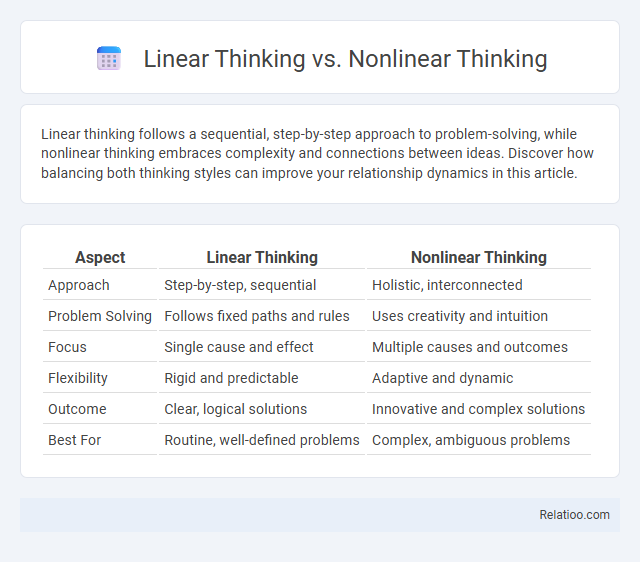Linear thinking follows a sequential, step-by-step approach to problem-solving, while nonlinear thinking embraces complexity and connections between ideas. Discover how balancing both thinking styles can improve your relationship dynamics in this article.
Table of Comparison
| Aspect | Linear Thinking | Nonlinear Thinking |
|---|---|---|
| Approach | Step-by-step, sequential | Holistic, interconnected |
| Problem Solving | Follows fixed paths and rules | Uses creativity and intuition |
| Focus | Single cause and effect | Multiple causes and outcomes |
| Flexibility | Rigid and predictable | Adaptive and dynamic |
| Outcome | Clear, logical solutions | Innovative and complex solutions |
| Best For | Routine, well-defined problems | Complex, ambiguous problems |
Introduction to Linear and Nonlinear Thinking
Linear thinking follows a sequential, step-by-step approach to problem-solving, emphasizing logical progression and clear cause-and-effect relationships. Nonlinear thinking embraces complexity by considering multiple variables and interactions simultaneously, often leading to innovative and holistic solutions. Understanding these cognitive styles clarifies decision-making processes and enhances adaptability in diverse scenarios.
Defining Linear Thinking: Concepts and Characteristics
Linear thinking involves a step-by-step, sequential approach to problem-solving, where each idea follows logically from the previous one. It emphasizes clarity, structure, and predictability, making it well-suited for tasks that require order and consistency. Your ability to apply this method facilitates straightforward analysis and decision-making in scenarios with clear cause-and-effect relationships.
Exploring Nonlinear Thinking: Meaning and Features
Nonlinear thinking involves recognizing patterns and connections beyond straightforward cause-and-effect relationships, allowing you to solve complex problems creatively. Unlike linear thinking, which follows a sequential path, nonlinear thinking embraces flexibility, intuition, and multiple perspectives, fostering innovation and adaptability. Features include divergent thought processes, holistic understanding, and the ability to synthesize seemingly unrelated information into meaningful insights.
Key Differences Between Linear and Nonlinear Thinking
Linear thinking follows a sequential, step-by-step approach aimed at clear cause-and-effect relationships, making it ideal for structured problem-solving and predictable outcomes. Nonlinear thinking embraces complexity, allowing multiple pathways and connections, which fosters creativity and adaptability in uncertain or dynamic situations. Your understanding of when to apply linear or nonlinear strategies can significantly enhance decision-making and innovation in various contexts.
Benefits of Linear Thinking in Everyday Life
Linear thinking enhances your ability to approach everyday problems systematically by breaking tasks into clear, manageable steps, boosting productivity and reducing stress. It supports consistent decision-making and effective time management, essential for achieving goals efficiently. This structured mindset helps your brain prioritize information logically, making complex situations more predictable and easier to navigate.
Advantages of Nonlinear Thinking in Problem Solving
Nonlinear thinking enhances problem-solving by enabling you to explore multiple possibilities simultaneously, fostering creativity and innovation. This cognitive approach allows for flexible adaptation to complex challenges where traditional linear methods may fall short. Embracing nonlinear thinking breaks conventional boundaries, leading to breakthrough solutions and greater insight.
Common Challenges with Linear and Nonlinear Approaches
Linear thinking often struggles with complexity due to its step-by-step, cause-and-effect approach that limits creativity and adaptability in dynamic environments. Nonlinear thinking can overcome these limitations by embracing patterns, relationships, and multiple perspectives, but it frequently faces challenges such as ambiguity, cognitive overload, and difficulty in structuring solutions. Boundlessness transcends these constraints by fostering integrative, flexible thinking that harmonizes linear and nonlinear methods, enabling innovative problem-solving in uncertain or complex scenarios.
Real-World Examples: Linear vs Nonlinear Thinking
Linear thinking follows a step-by-step approach, ideal for tasks like assembly line manufacturing where predictable, sequential processes ensure efficiency. Nonlinear thinking, exemplified by marketing strategy development, embraces complexity and multiple variables to adapt to changing consumer behaviors. Boundlessness transcends both by integrating diverse perspectives and fostering innovation in fields like artificial intelligence, where solutions are not confined to linear or fixed nonlinear frameworks.
When to Use Linear or Nonlinear Thinking
Linear thinking excels in structured tasks requiring step-by-step problem solving, such as data analysis and process optimization. Nonlinear thinking thrives in creative endeavors like innovation and strategic planning, where diverse perspectives and abstract connections drive breakthroughs. You should harness linear approaches for predictable scenarios and switch to nonlinear methods when facing complex, ambiguous challenges that demand flexibility and out-of-the-box solutions.
Cultivating Both Thinking Styles for Personal Growth
Cultivating both linear and nonlinear thinking enhances problem-solving and creativity by balancing structured analysis with innovative intuition. Linear thinking prioritizes step-by-step logic and sequential processing, essential for systematic planning and decision-making. Integrating nonlinear thinking, which embraces complexity and spontaneous insight, fosters adaptability and boundary-breaking ideas crucial for personal growth and innovation.

Infographic: Linear Thinking vs Nonlinear Thinking
 relatioo.com
relatioo.com